By DAVE KEHR
First Published: January 20, 2002, by The New York Times
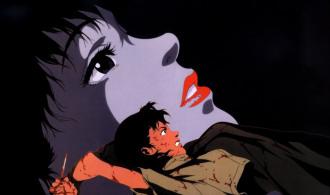
Perfect Blue (reviews.minitokyo.net)
(Editor’s Note: This is a reprint of an article that first appeared over ten years ago. Since that time, my family and I have been constant convention-goers and frequent participants in anime-related events, including lectures, panels, artist’s alleys, skits and “cosplays,” most prominently at the annual Animazement Convention in Raleigh, North Carolina, as well as quite a few others. Let this excellent article by Dave Kehr serve as an introduction, or “crash course,” to those unfamiliar with the anime genre or its basis in Japanese– and American — culture and cinema.)
It is easy to get the impression that the Japanese cinema disappeared from the world stage with the passing of its three greatest filmmakers, Kenji Mizoguchi, Yasujiro Ozu and Akira Kurosawa. Since Kurosawa’s death in 1998, a number of gifted directors have emerged in Japan, including Takeshi Kitano (Hana Bi) and Shinji Aoyama (Eureka). But none of them have been able to fill American and European art houses as their elders did in the 1950′s and 60′s, when Japanese film was in its golden age.
But in fact, Japanese film has probably never been as popular internationally as it is right now. Its popularity, though, is not grounded in live action films, but in the animated features and television series that have come to be known as anime. It has been estimated that anime (AH-nee-may) now account for 60 percent of Japanese film production. The term itself — a Japanese adaptation of the English “animation” — suggests the roots of the form, in a blending of the Japanese pictorial tradition represented by silk painting and woodblock prints with American-style character design and genre stories.
After a decade or two as an underground phenomenon in the United States — where legions of obsessive fans exchange fuzzy videotapes or, more commonly now, trade bootlegged movie files over the Internet — anime is slowly emerging into the light of day. Hayao Miyazaki’s Princess Mononoke was released by Miramax in 1999 in a dubbed version, featuring the voices of Claire Danes, Gillian Anderson and Minnie Driver; Katsuhiro Otomo’s 1988 Akira opened theatrically last year in a digitally restored edition (and is now available on DVD); last summer Columbia Pictures released The Spirits Within, an elaborate computer-animated episode of the long-running “Final Fantasy” series; and opening on Friday is Metropolis, a fascinating blend of computer and traditional hand-drawn animation directed by Rintaro and based on a 1949 comic book written by Osamu Tezuka.
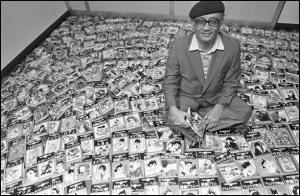
Osamu Tezuka, surrounded by his manga
Anime is not a genre in itself, but a style that can be applied to a wide variety of subject matter. The Japanese cartoon can and has embraced a dizzying number of genres, from Disney-like childhood adventure (Mr. Miyazaki’s specialty) to astonishingly violent, graphic pornography (in series like Raizo Kitazawa and Kan Fukumoto’s La Blue Girl). In fact, many anime films take pleasure in mixing and matching various genres and periods, as does the very popular Cowboy Bebop television series with its blend of westerns, samurai dramas, Blade Runner-style retro-futurism and cuddly character interactions that suggest American sitcoms.
But there are certain constants in the form. Most conspicuously, there is the look of the characters, which, while allowing for some minor variations from artist to artist, generally insists on impossibly statuesque bodies topped by huge, heart-shaped faces, themselves punctuated by gigantic, round eyes of the depth and limpidity of Beverly Hills swimming pools. Westerners are often struck by how “un-Japanese” they look, with their curly hair that comes in shades of blond, red and blue.
Part of the reason for those design choices is surely cultural, and as such beyond the reach of mere film criticism. But historically, the style began with the great admiration that Tezuka, the grand old man of Japanese animation, bore for the work of Walt Disney. Tezuka’s first widely popular character, born in a 1951 comic book, was Astro Boy, a space-age Pinocchio who substantially predates Steven Spielberg’s A.I. Astro Boy is a robot created by a scientist whose own child was killed in a car accident; when the robo-child disappoints his creator by his failure to grow up, he is sold to a circus with a cruel ringmaster (another A.I. parallel), but eventually finds happiness with a kindly professor who teaches him to fight crime (and who builds him a loving little robot sister).
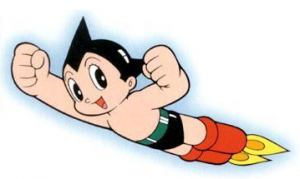
Astro Boy
Tezuka turned his comic strip into an animated TV series in 1963, and the character immediately became a worldwide success. Astro Boy’s simple, spherical construction suggests both the early Mickey Mouse and Max Fleischer’s Betty Boop, and a 1930′s Deco elegance clings to the design even today. The anime filmmakers who followed Tezuka – in the boom in theatrical and television animation engendered by the success of Astro Boy [originally titled The Mighty Atom] – imitated his style, establishing what was, in fact, a specific, strictly dated form of 1920′s-30′s graphic design as the baseline of the new medium. At times, anime figures look strikingly like the sexualized children created by the Chicago outsider artist Henry Darger.
Metropolis, the anime that opens this week, is a fantasy inspired by a still photograph from Fritz Lang’s German silent film of the same name (Tezuka claimed never to have seen it). As translated to the screen by Rintaro, an animator who worked with Tezuka on the original Astro Boy series, the film is a charming blend of Tezuka’s old-fashioned cartoon figures and the most up-to-date computer animation technology, used to generate dizzying perspectives and richly detailed backgrounds.
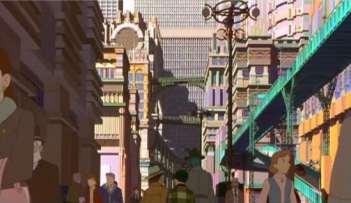
Futuristic city of Metropolis
Though Metropolis emphasizes the contrast between the dated, naïve figures in the foreground and the high-tech design of the background, it isn’t unusual to find a similar, if unarticulated, dissonance in other anime. Originally designed for the low budgets of television production, anime — like the American style pioneered by Hanna-Barbera for Huckleberry Hound and The Flintstones around the same time — uses fewer drawings per second than the vintage Warner Brothers or Disney cartoons, which were made at a time of lower costs and greater theatrical exposure. Even so, now that computers have made it possible to create smooth, fluid animation for a reasonable cost, the Japanese films hang on to the jerky, discontinuous movements that characterized the earliest work in the field. This is something that can pose a problem for Western viewers, who risk seeing the anime style as something inherently inferior to the sleeker Hollywood product.
But there is much in the work to suggest that this jagged, flip-book quality is an effect that Japanese viewers find desirable and pleasurable. Accustomed to manga — the massive comic books published in Japan for adults as well as for children — the Japanese public does not favor movement over composition as a principle of expression. As more than one commentator on manga has pointed out, the most direct precursor of the form is ukiyo-e, the woodblock prints — themselves often erotic or rudely caricatural — published in nineteenth-century Tokyo. Here, the artists often strove to convey movement — crashing waves, raging battles, swirling geishas, kabuki performers in high dudgeon — in terms of static line drawings, in ways that powerfully suggest the contained dynamism of the anime style.
Perhaps the best way to appreciate anime is as a series of still drawings with moving details. Even a film like Mr. Miyazaki’s Princess Mononoke, with its clear aspirations to Disneyesque detail and grandeur, animates its characters with only slightly more grace and fluidity than a low-budget television series like Angel Tail. The figures themselves are as flat as the backgrounds, given only a suggestion of dimensionality by solid wash shading.
Where Western animators struggle to create a convincing illusion of life, Japanese animators are more interested in capturing single expressive gestures, or in evoking a particular mood through the careful use of color. Unlike Hollywood animation, anime does not aspire to the condition of live-action cinema; it remains its own stubborn self.
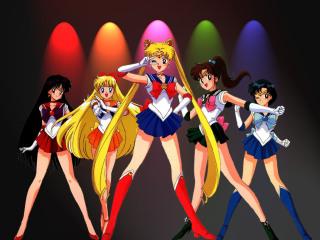
Sailor Moon (center) and Sailor Scouts
The range of achievement in anime is immense, from instantly disposable Saturday morning children’s fodder — like Sailor Moon or the interminable Pokémon series — to work that stands with the finest the world cinema has produced in the last 20 years. But even in its less honorable forms, anime has proven to be a rich source for cultural anthropologists, who find in it a vivid illustration of the dissolving identities and collapsing institutions that characterize life in postmodernist cultures.
Susan J. Napier, a teacher of Japanese literature and culture at the University of Texas, has published a thoughtful and carefully researched account of the social and sexual values encoded in the form in her recent book Anime from ‘Akira’ to ‘Princess Mononoke.’ For Ms. Napier, the heroes of anime are defined by their indefiniteness — by their curious tendency to shift back and forth between male and female bodies (as in the popular Ranma 1/2 series) or, thanks to bodies that have been fitted out with all kinds of high-tech refinements and super-human replacement parts, by their extremely ambiguous status as human beings.
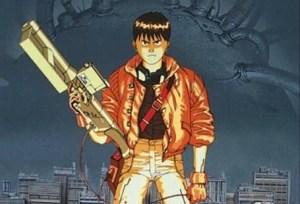
Akira
The protagonist of Akira, Katsuhiro Otomo’s influential 1988 film, is a disaffected teenager whose massively destructive psychic powers are unleashed by a series of army experiments. The heroes of the long-running series Guyver and Neon Genesis Evangelion are young men who become monsters of destruction when they strap on high-tech body armor; they are both empowered and overwhelmed by merging with the electro-mechanical world. (Expressed already in Astro Boy, this is perhaps the most deeply embedded theme in the anime universe.)
If this view of technology is open to charges of simplification and sentimentality — not to mention obvious Freudian interpretations centered on adolescent fears of the developing body — there are other anime that seem eager to advance to the next stage in human development.
Mamoru Oshii’s Ghost in the Shell, a 1996 feature based on a manga by Masamune Shirow, surely ranks with the finest Japanese films of the last two decades (a beautifully produced DVD is available from Manga Video). Its protagonist is Kusangi, a female cyber cop assigned to duty in what appears to be a slightly futuristic Hong Kong; in the course of investigating a criminal programmer called the Puppet Master, she begins to question her own identity. Is she human or machine, male or female, alive or dead? The film’s delirious climax finds her merging with the Puppet Master and entering a transcendent state beyond such narrow categorizations.
Still, for all of its philosophical speculations, what is most impressive about Ghost in the Shell are its purely lyrical moments — sequences in which Mr. Oshii leaves the narrative in abeyance to offer wordless images of daily life in this strange city of the future, images rendered with a serene stillness and a compositional rigor that vividly recall the wordless sequences, or “pillow shots,” that Yasujiro Ozu inserted between his dramatic segments. Even if these images add nothing to the story, they complement the film’s headlong thematic thrust into the future with an assertion of traditional Japanese values. Here again is that sense, so powerful in Ozu and Mizoguchi, of “mono no aware” — a recognition of the ephemeral nature of human life, an awareness of the ineffable sadness of things.
Satoshi Kon’s Perfect Blue (1997) leaves the boy’s adventure archetypes behind; its main influences would seem to be David Lynch and Michelangelo Antonioni. Like Mr. Lynch’s recent Mulholland Drive, the film is a study in mutable realities and dissolving identities, with an actress as the central figure: Mima Kirigoe is a moderately successful pop singer who hopes to move into an adult career as a dramatic performer. But her dreams are dashed when an alternate Mima appears, who — wearing the pigtails, pink hair ribbons and tutu that were Mima’s trademarks — begins brutally murdering the advisers who are supervising her transition to womanhood.
Mima’s evil twin embodies the innocent, super-cute girlishness that the Japanese call shojo (series like Sailor Moon, or the products in the Hello Kitty line of children’s toys, illustrate the concept in all its bubblegum-pink glory). Within the context of a psychological thriller, Mr. Kon explores the crisis of Japanese women entrapped by the crippling shojo image, which is seen as spreading its pernicious influence over several generations. Perfect Blue, which also contains some brilliantly executed expressionistic imagery of Tokyo at night, is one of the rare anime to venture into overt social criticism; in a medium that relies on the shojo image for much of its male appeal, the gesture is quite radical and courageous, though the film ultimately retreats into a disappointingly pat thriller.
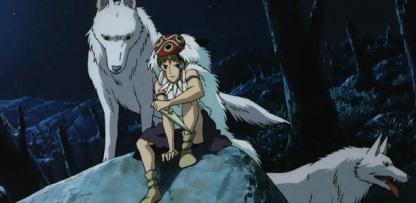
Princess Mononoke
If anime has one director with a claim to worldwide stature, his name is Hayao Miyazaki, the creator of Princess Mononoke as well as eight other features and four television series. Mr. Miyazaki has often been called “the Walt Disney of Japan,” and the comparison is actually more profound than it may appear. Like Disney in his early features, Mr. Miyazaki deals with the deepest kind of childhood trauma — the loss of a parent, the resentment of a sibling, the difficulty of belonging to a family and the difficulty of separating from it — and he does so in terms that, while sometimes superficially sentimental, also contain solid truths.
From his earliest features — The Castle of Cagliostro (1979), Nausicaa of the Valley of the Wind (1984) and Castle in the Sky (1989) — Mr. Miyazaki has separated himself from the pack of anime artists by his refusal of technology-driven stories and techniques. Despite an increasing use of computer animation in his backgrounds, he continues to hand-draw his principal characters. Some of his work is set in a vaguely European past — Cagliostro revives the turn-of-the-century gentleman thief Arsène Lupin and sets him loose to save a Ruritanian princess from the clutches of evil counterfeiters — while other films refer to a much more specifically Japanese world (unusual for anime), such as the softly rendered early 1950′s of My Neighbor Totoro (1988). Mr. Miyazaki is no futurist, but a fantasist who re-imagines the past.
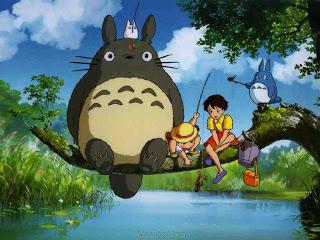
My Neighbor Totoro
In My Neighbor Totoro, two small children, Satsuki and her younger sister Mai, are uprooted from their urban world and sent to live in a decaying country house near where their mother is being treated for a serious illness. Their father does his best to protect the girls from the gravity of the situation, but it still affects them subconsciously. Mai, wandering through a neighboring forest, encounters a lumbering creature who looks like a cross between a kitten and a bright blue walrus. Mai crawls on his stomach, pokes him awake and asks him his name. The creature replies with a growl that sounds like “Totoro,” and Totoro he becomes.
The implication is clear that Totoro is an imaginative projection of the children — a benign, protective spirit who will help the sisters through their mother’s illness. But Mr. Miyazaki also suggests that these beings are descendants of the forest-dwelling gods of the ancient Japanese religions, that they carry with them the power and magic of nature itself. Psychology and the supernatural are seen as forming a seamless whole, ultimately indistinguishable from each other in their aspirations and human values.
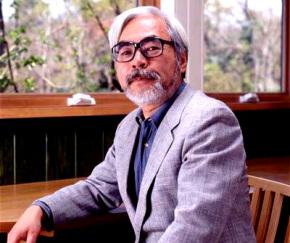
Filmmaker Hayao Miyazaki
Princess Mononoke is Mr. Miyazaki’s finest achievement to date, and perhaps the one anime that need not shrink from comparison with the great Japanese live-action films of the 1950′s. This complex, ambiguous, thematically dense epic transcends classification as a children’s fantasy; indeed, it has become the highest-grossing Japanese film ever [surpassed, in more recent years, by his own Spirited Away], as popular and meaningful to adults as it is to children.
There are no cuddly Totoros here: this is nature red in tooth and claw. The film, set in the fourteenth-century Muromachi period, centers on a young hunter, Ashitaka, who finds himself caught up in a war between an ancient world shrouded in mystery and violence, represented by the forest-dwelling wild child of the title, and a new world of civilization, militarism and communal values embodied by a fortified village whose specialty is the manufacture of firearms. Remarkably, neither world is privileged above the other in Mr. Miyazaki’s screenplay. Rather than presenting a simple, sentimental ecological fable, the film is profoundly engaged with complex, irresolvable issues.
It is also a work of astounding formal beauty, in which elaborate, computer-generated backgrounds merge seamlessly with the vigorous, hand-drawn animation of the foreground characters. Perhaps no Japanese film has found the same sense of scale and sweep since Akira Kurosawa’s The Hidden Fortress in 1958. It is tempting to see in Mr. Miyazaki’s work — if not in anime in general — the extension of the epic ambitions that the Japanese cinema, led by Mizoguchi and Kurosawa, once harbored and once realized.
If the budgets of the 1950′s are no longer available — thanks in no small part to the near hegemony Hollywood has achieved over the world’s popular entertainment — anime has allowed Japanese film-making to survive and prosper in a different way, without sacrificing the qualities that once made it so vital, so significant and so distinctive.
Princess Mononoke was released in Tokyo on July 12, 1997; Akira Kurosawa passed away just over a year later, on Sept. 6, 1998. Perhaps he lived to see Mr. Miyazaki’s film; perhaps he saw something of himself in it.
Copyright © 2002 by The New York Times


posted on 18 November at 17:38
Disney influenced anime/manga? That's just laughable. Ever notice that the anime style look's nothing like anything Disney or Tezuka ever made? Disney kiss-asses like to say that one of anime's primary features is big eyes, and then say that because Tezuka was a big Disney fan and made big eyed characters because the Disney animations he watched had big eyes, That Tezuka is the "creator" of anime, and therefore anime was influenced by Disney. First of all, anime is defined by the SHAPE of the eyes. size has nothing to do with the look. And I know that nobody else came up with the iconic eye shapes anime is known for besides the Japanese themselves. Osamu only made characters with big eyes, he never came up with any distinct eye shapes. And it's not like the Japanese couldn't have come up with any eye sizes and shapes all on their own. They had characters in their ancient woodblock and painted pictures with pretty wide eyes. Something as simple a concept as eye sizes is not the kind of thing that could only be distinct of a certain culture, come on now. Second, even when Tezuka's "style" was being mimicked by other Japanese artists, there were still mangaka coming up with styles that were completely untouched by Disney influence. Most notably "Monkey Punch", creator of Lupin III. During the 70's there were a lot of anime being made that not only had an entirely, uniquely Japanese look, but a good number of them had characters whose eyes were not noticeably big. THIS is the time when the anime style was developing it's distinct look, and very few anime being made during that time had even the slightest resemblance to the look of Osamu's and Disney's works. Most people who have seen what anime looked like, beginning with Lupin III and late 70's anime up till now, see an entirely unique and distinctly Japanese art style, not something resembling generic Disney or Tezuka character types. Anime is a distinct and uniquely Japanese art style full of such realistically detailed art, aside from the eye shapes and a few facial features (which as far as said facial features go, aren't even that noticeably unrealistic) and when combined together, makes up the whole look and feel of anime that is simply unparalleled. True anime lovers know this all too well. To say that anime was influenced by Disney, when it's a distinct art style defined by specific eye SHAPES, the general level of detail in the art, and overall realism in the anatomy, is just plain ignorant of other culture's abilities to innovate in the fields of art, independent from needing the west to give them a jump starter. http://www.mit.edu/~rei/Expl.html,http://www.escapistmagazine.com/...,http://www.animenewsnetwork.com/bbs/phpBB2/viewtopic.php...,http://www.gaiaonline.com/.../t.69804341_16/.